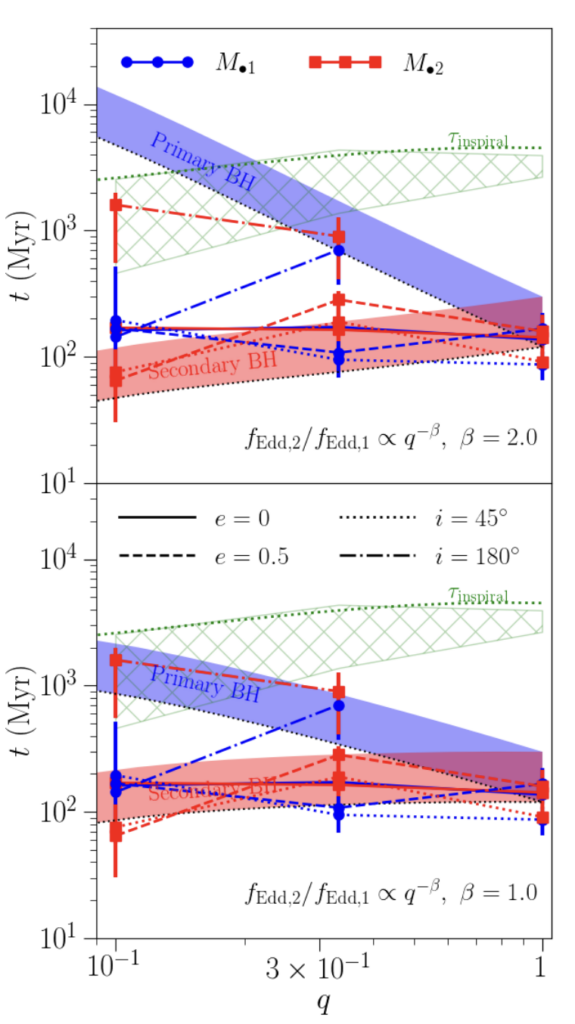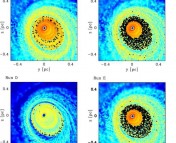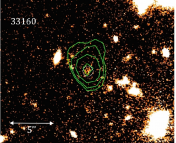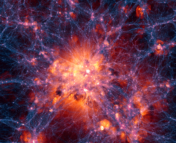Authors: Martin A. Bourne, Davide Fiacconi, Debora Sijacki, Joanna M. Piotrowska, Sophie Koudmani
First Author’s Institution: Institute of Astronomy, University of Cambridge, Madingley Road, Cambridge, UK
Status: Submitted to MNRAS, available on arXiv
Supermassive black hole (SMBH) binaries are often found at the centres of merged galaxies. In environments abundant with gas, a massive, gaseous accretion disk can form around the binary (see Figure 1), called a circumbinary disk (CBD). CBDs are one of the proposed channels contributing to bringing SMBH binaries to close separations, eventually resulting in the merger of the two black holes via the emission of gravitational waves.

Recently, pulsar timing arrays (PTAs) found evidence hinting at a background of gravitational waves potentially coming from a population of SMBH binaries. This has opened a new window for investigating these fascinating objects, with future missions such as LISA (Laser Interferometer Space Antenna) proposed to explore individual SMBH mergers. Therefore there is a need to give theoretical predictions on the rate of observable SMBH mergers and binary parameters including the black hole spins and orientation.
One major question is how the spins of SMBHs evolve and what role a circumbinary disk plays in their evolution. Will interactions with the CBD align the spin axes of the black holes with the disk’s angular momentum? This has important implications for what happens after a merger — when SMBHs have large, misaligned spins prior to merger, the remnant could take on a high recoil velocity and potentially be kicked from the host galaxy!
In today’s paper, the authors investigate the role of a CBD in the dynamics and alignment of SMBH spins through a 3D, high-resolution, hydrodynamic simulation. The parameters of the binary and the orbits are chosen such that they fall in the observing range of the LISA.
How does the disk interact with the binary orbit?
To explore the evolution of the SMBH binary and the CBD, the authors perform simulations across a range of binary mass ratios, eccentricities, and inclinations of the orbits. Figure 2 shows the time evolution of the semi-major axis and eccentricity of the binary orbit for different binary orientations (i.e., initial inclinations). In all cases, we can see that the semi-major axis of the binary decreases and eccentricity increases over time. This observed behavior is gas accretion and gravitational torques exerted by the disk on the binary. This is due to the gas accretion and gravitational torques exerted by the disk on the binary. The net torque experienced by the binary is causing their orbits to shrink and driving them to a merger.

The authors also look at gas accretion onto the black holes. Previous simulations have shown that the secondary (i.e., initially smaller) black hole preferentially experiences stronger gas accretion, driving the mass ratio of the binary system to one. However, the authors see a different picture. They find that the accretion happens preferentially onto the primary, initially larger black hole, implying a constant binary mass ratio till the merger.

For a fixed binary total mass, equal mass binaries (mass ratio is unity) provide the highest amplitude gravitational wave signals. If there is no preferential accretion to secondary, the low mass ratio will stay the same up to merger. They will produce lower gravitational wave strain amplitudes and hence a weaker gravitational wave background. The authors suggest that the lack of preferential accretion in their simulations is due to the differences in their model compared to traditional simulations.
To align or to misalign?
The simulation gives a detailed look into the evolution of the black hole spins and angular momentum of the disk, providing an opportunity to check for alignment of the spins and the angular momentum. The authors see that the timescale for spin alignment (i.e. time taken for the black hole spins to align) is shorter than the time taken for the binary to inspiral and merge. In Figure 3, the authors compare the spin alignment and binary inspiral timescales from the simulations to an analytical model. When preferential accretion onto the second binary is not assumed (lower panel in figure 2), the spin alignment timescale is always lower than the inspiral timescale — even in low mass ratio systems.
Black hole spins are therefore expected to align for cases where the binary orbit is co-planar with the disk. However, if there is an initial misalignment between the CBD and the binary, spin alignment is not guaranteed. In this case, the black hole spins can remain misaligned before the merger, and the remnant black hole would receive a recoil kick — effectively, a velocity boost. If the kick velocity is greater than the escape velocity of the host galaxy, the black hole would be ejected. This will affect the number of supermassive black holes occupying galaxy centres and the gravitational wave detection rates. Hence, it is important to carefully study spin alignment as it plays a big role in the recoil process.
To sum up, today’s paper shows how CBD affects SMBH binary evolution. The authors show that the disk causes the binary orbit to shrink and the black hole spins to align with the disk’s angular momentum. Simulations such as this shed light on various physical processes in an SMBH binary evolution and is crucial for providing predictions for future gravitational wave events for detectors like the PTAs and LISA.
Astrobite edited by Mark Dodici
Featured image credit: Adapted from NASA’s Goddard Space Flight Center Conceptual Image Lab and Wikimedia Commons




